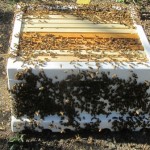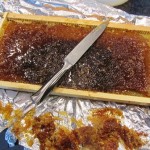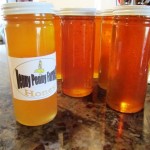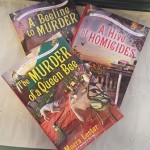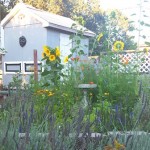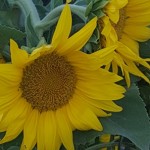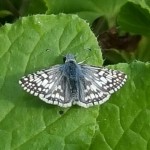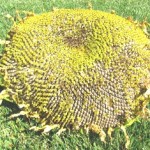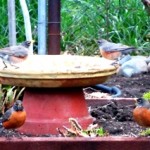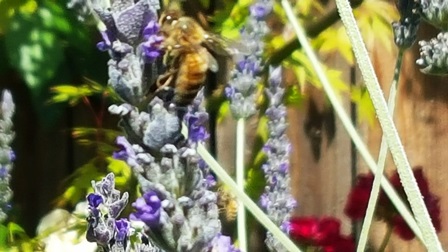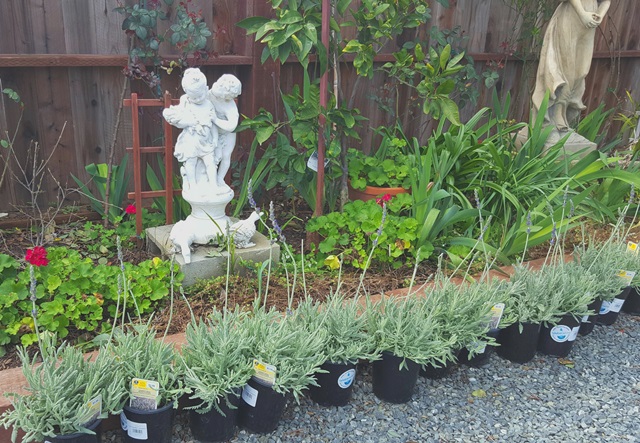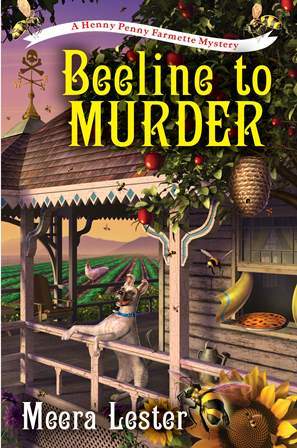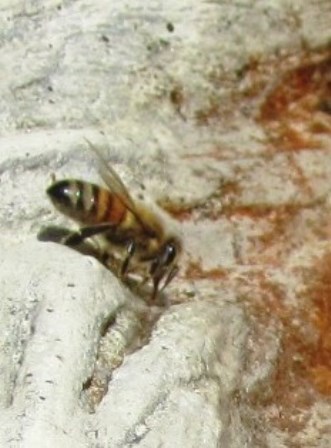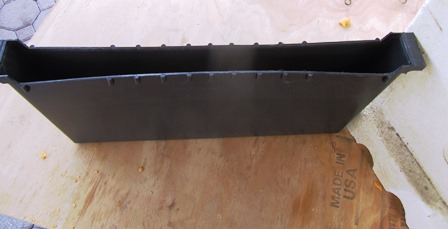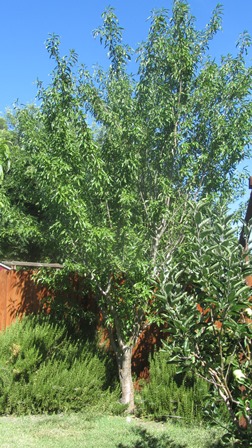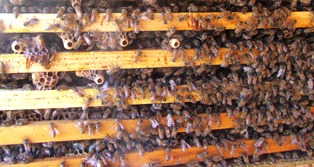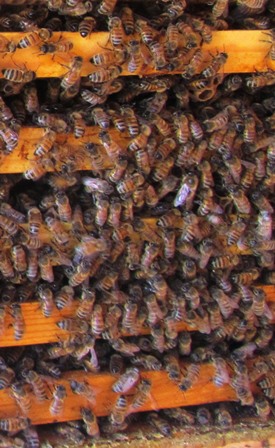Keeping Bees Feeds the Family
The sight of bees collecting pollen makes me happy. Always has. Honeybees are vital to the production of the foods we love such as almonds, apples, citrus, melons, and a large variety of vegetables. My vegetable garden and fruit trees are incredibly productive because of my backyard bees. I guess you could say they feed my family through pollination.
Bees are pollinators. Without them there’s a good chance we’d suffer food scarcity on our planet. Three out of four crops around the globe that are foods that we humans eat are dependent in large part on pollinators. Honeybees also produce honey, nature’s most delicious sweetener, in my opinion.
I keep hives of honeybees on my farmette. It’s not a commercial operation but a backyard hobby that supplies honey for my family and friends as well as pollinating a huge variety of vegetables, fruits, and berries that I grow. Caring for the bees is relatively easy. Harvesting honey, on the other hand, is a bit of work but work I am happy to do.
The first step in harvesting honey is to open the hives. The use of a smoker helps calm the bees. Working quickly is a good idea. We never remove all frames of honey from the hive, but rather leave frames with baby bees and some frames with honey so the bees have food, too.
New frames (some are previously used frames that have the wax structure intact) are inserted to replace the removed frames of honey. A super with 10 frames of honey is carried into my kitchen. Inevitably, I have to capture and release a half dozen live bees that ride in on the frames.
Each frame then gets a hot knife slipped just under the layer of wax. With the wax removed from both sides of the frame, only honey is left. This must be spun out or drained off.
I put four frames of honey at a time into the spinning machine in my kitchen. Beneath the machine’s spigot is freshly washed honey bucket, draped with a new cloth strainer that I’ve taped in place over the top of the bucket. It will catch any pieces of wax or other debris.
When the bucket is full, the strained honey is poured into jars to use, store, or give away as gifts. I put a tight-fitting lid on the bucket and keep the bucket within easy reach on the kitchen countertop.
We eat honey year round. I especially love it in the winter because it reminds me of the honey-flow in spring when the farmette smells like honey and my kitchen is saturated with the scent after pulling some frames from the hive.
Also, the vegetables and fruits that I harvest throughout the growing season are either immediately consumed or preserved through hot-water canning, dehydration, flash freezing. I thank Mother Nature for the blessing of bees that pollinate our foods and give us delicious honey from their hive–up to six gallons for ten frames from a full-depth box!
*NOTE: Learn more about honey bees at: https://www.nationalgeographic.com/animals/invertebrates/h/honeybee/
Also, check out: https://honeybeenet.gsfc.nasa.gov/Honeybees.htm
___________________________________________________________
Enjoy reading about country living? Check out my Henny Penny Farmette series of cozy mysteries that also include lists of farm chores, delicious recipes, farm sayings, and tips for healthy living. Or, take a look at my health, wellness, and spirituality books. All are available online and everywhere books are sold.

More than 150 rituals for sound mind, strong body, and meaningful connections to the people around you
Swarm in July–Does It Really Mean, “Ain’t Worth a Fly?”
Yesterday, after I’d fed and watered the chickens, I grabbed a two-gallon bucket and a ladder to pick some apricots for canning. But my morning didn’t go as planned when I spotted a cloud of bees swarming in the very fruit tree I was preparing to climb into. Nothing like a honeybee swarm to make you switch tasks in a hurry.
There’s a centuries-old saying among beekeepers: A swarm of bees in May is worth a load of hay . . . a swarm of bees in June is worth a silver spoon . . . a swarm of bees in July ain’t worth a fly. My beekeeper neighbor says simply, “A swarm in July . . . bye bye.” The rhyme echoed in my brain. Even early July? Should I try to save them? I donned my beekeeper suit and gathered together the items I would need for the rescue.
Ironically, in late winter I had hung a swarm catcher in the tree next to the swarm. A swarm catcher makes it easy to hive the bees since they are all inside the bucket-shaped unit with a small hole on one side and a large covered opening on the other. They go inside and you dump the bees into the hive box. I’ve had three swarms this year and not one of them went into the swarm catcher despite me putting attractant (a type of scented oil) in the vial inside the unit. Go figure!
Yesterday’s swarm wasn’t as big as the two I captured in May and June. I’m not even sure if I could save this one, but trying was better than losing them. I decided to help the small population along but putting into their hive some frames of comb and honey.
A swarm at this time of year (approaching the end of swarming season) will require extra food if the bees are to make it through autumn when they kick out the drones and then winter when their food and nectar sources become scarce.
I draw hope from the fact that August in the Bay Area brings blooms to certain species of eucalyptus and also star thistle. My bees also have access to lots of lavender. I have planted several types of it around my farmette.
The sunflowers in my garden are blooming now and will (thanks to consecutive planting) over the next several weeks. And I’ve got two raised beds designated as bee gardens full of blooming flowers and herbs like borage that attract bees, butterflies, and other pollinators.
It remains to be seen if this July swarm will have any worth at all. I think they’re going to need a lot of help. That means keeping my eyes on them as I take care of my chickens and keep the summer canning going.
_____________________________________________________________________________
If you enjoy reading about the workings of an urban farmette and also appreciate a good, clean mystery, check out my Henny Penny Farmette series of cozy mysteries–A BEELINE TO MURDER, THE MURDER OF A QUEEN BEE, and A HIVE OF HOMICIDES. I also write wellness and spirituality books–SACRED TRAVELS (soon to be updated to include color images), RITUALS FOR LIFE, and MY POCKET MEDITATIONS.
All my books are available at Barnes & Noble, Amazon, and other traditional and online bookstores everywhere.

More than 150 rituals for sound mind, strong body, and meaningful connections to the people around you
Plant for the Pollinators
I seldom need an occasion to put in another bed of flowers, but this is National Pollinator Week. I think a new bed is in order to attract local bees, birds, bats, and butterflies–all considered pollinators. Having these small creatures around benefits landscapes, gardens, and orchards.
The U.S. Fish and Wildlife Service has noted that over 75 percent of our plants are pollinated by birds, animals, and insects. We can help ensure these creatures will be around for a long time if we restore their habitats and ensure they have food and water.
There are many lovely plants you can grow that don’t require a lot of care.
- lavender
- bee balm
- echinacea
- sage
- cilantro
- thyme
- sunflowers
- sweet alyssum
- anemone
- borage
- geraniums
- scented pelargoniums
- mint
A tapestry of colorful herbs and flowers beautifies your landscape and pollinators love the diversity. If you don’t have a lot of space, grow some of these plants in planter boxes, clay pots, or other types of containers.
Put in a water feature, too, such as a table-top or larger fountain that recycles water. Even a pottery saucer filled each day can attract pollinators.
It won’t take long for the bees and hummingbirds to find the water. Their frequent visits are fun to watch, and they’ll likely be sipping throughout the day.
_________________________________________________________________________
If you enjoy reading about farmette topics, check out my Henny Penny Farmette series of cozy mysteries from Kensington Publishing. My newest novel includes delicious recipes, tips on keeping bees and chickens, and much more. Click on this URL for more information, http://tinyurl.com/ya5vhhpm
.
French Lavender–A Favorite of Pollinators
It’s bare-root season, a special time of the year for me. I like to visit local nurseries and check out the new offerings of heirloom roses, fruit trees, berries, herbs, and flowers. No matter which nursery I visit, I always seem to spot the lavender first.
After we moved to the Henny Penny Farmette, we put in lots of French lavender. But after a few years, the stalks have grown old and woody.
Recently, on a visit to a nearby nursery, we purchased twenty one-gallon plants of French Lavender, an upright perennial that we’ve discovered blooms almost all year long in our Bay Area climate.
Now, they are hardening off in my garden until I get around to planting them.
The word “dentata” means toothed and a closer examination of the foliage reveals fringed indentations.
This aromatic, shrub has been around for centuries. Valued for its ornamental and medicinal properties, it also is used for soil erosion control. Once established, the lavender is drought tolerant.
Many gardeners love this lavender for its gray-green leaves. When other flowering plants in the garden have finished their blooming cycle, this lavender keeps producing tall spikes of bright purple florets.
Not as brilliant in color as the English or Spanish lavender, the French lavender is lovely grouped together in a single area where its flower stalks can sway in the wind. Our honeybees and other pollinators love it.
* * *
If you are a fan of cozy mysteries and love farmette topics like gardening of heirloom vegetables, herbs, and fruits as well as keeping chickens and bees, check out my Henny Penny Farmette series of cozy mysteries from Kensington Publishing.
Besides a cozy mystery to solve, these books mix in delicious recipes, farming and gardening tips, facts about keeping bees and chickens, and morsels of farm wisdom.
- COMING SOON– Sept. 2017, the third novel in the Henny Penny Farmette series
To Feed or Not to Feed the Bees?
Mid-September is a time when beekeepers check their hives and consider the prudence of harvesting more honey or leaving it as well as whether or not to feed the bees. Honeybees, like many living creatures on our planet, need food and water to survive.
My wise beekeeper neighbor tells me that the hive needs to have sixty pounds of honey to make it through winter. He’s feeding his bees now a mixture of sugar and water.
The sugar-water inserts are black plastic holders that get inserted right into the hive in place of a frame. They are rigid enough to hold the sugar-water but pliant enough to swell outward, so conventional wooden frames of honey and wax help them stay in place. The downside is that bees can drown in these feeders. And if the beekeeper lets them go empty, the enterprising bees will just build comb and honey inside them.
There are several kinds of feeders–all with benefits and also drawbacks. For more information on feeders, see: http://www.honeybeesuite.com/what-type-of-honey-bee-feeder-is-best/
Last year, I didn’t take honey in the fall. I wanted to ensure the bees had what they needed to survive after they’d been through yet another summer of drought. There aren’t a lot of pollen-rich flowers to be found now. However, star-thistle still dots dry hillsides of Contra Costa County (where I live) and particular eucalyptus species that the bees like are blooming now.
I’m hopeful that this will be the last year of drought for a while. Weather forecasters say we have a strong El Nino that’s formed and will likely bring rain during our rainy season (November through April). That will be good news for the bees and those of us who love to plant flowers in our gardens to attract pollinators. But until the wet stuff starts coming down and new pollen sources are abundant, we beekeepers need to keep a close watch on our industrious little honeybees.
Northern California Nut Trees in a Nutshell
Take a trip into Northern California’s great Central Valley and you’ll notice how the landscape becomes dotted with nut tree farms along with vegetable fields, fruit tree orchards, and dairy farms. While Texas dominates the pecan tree market, California’s big three nut crops are almonds, walnuts, and pistachios. With nut prices on the increase, backyard gardeners might consider planting a tree or two if they have the space.
Some nut trees, such as almonds, require pollination assistance–a couple of different cultivars and honeybees will do the trick. For this reason, commercial almond growers pay beekeepers to bring their hives in to pollinate California’s early almond crop each year. Growing almonds is big business in California (it’s the third leading agricultural product in the state); the decline in honeybee populations is bound to affect this profitable crop.
The Central Valley has the perfect climate and growing conditions for almonds. It’s estimated that there are roughly 5,500 almond growers in the state. Many are commercial growers who capitalize on the rich, well-drained soil, and the hot summers and cool winters of Northern California. But California’s continuing drought is causing concern to almond growers since almonds require a lot of water. Backyard gardeners, too, must consider the water requirement of almonds before planting trees.
A newly formed almond on the tree looks like an unripe fuzzy peach because almonds are related to the peaches. Mature almond trees reach 20 to 30 feet tall. Some popular cultivars in zones 5 through 8 are Hall’s Hardy, Nonpareil, Peerless, and Mission. My neighbors have gorgeous, healthy almonds growing on their farmette.
The California Black Walnut and Persian Walnut (with cultivars of Franquette, Chandler, and Hartley) are valued for their stateliness, shade, bountiful crops, and longevity. Walnuts contain healthy nutrients. Cultivars of the English walnut are fast-growing and the nuts are thin-skinned and bountiful.
If a walnut is planted at the birth of an individual, and he lives 75 years, that walnut tree might could still be growing when the person breathes his last breath. The black walnut can reach 100 feet in height. The nuts have an thick outer hull that can blacken sidewalks and driveways with their stain; also, the tree also can be toxic to other plants.
In comparison to walnuts, filberts/hazelnuts are considered small trees (achieving heights of only 10 to 40 feet), they are often the nut tree of choice for backyard landscapes. DuChilly and Daviana are excellent pollinizers with Barcelona. Other cultivars are Bixby, Royal, and Hall’s Giant.
Pecan trees grow much larger than filberts, often towering 70 to 150 feet. Some cultivars include Major, Peruque, Stuart, and Colby. The cultivars of Wichita, Western Schley, and Cherokee are excellent pollinators for each other. Of all the nuts valued for their antioxidants, pecans rank the highest.
There is a pistachio tree growing a mile or so from my farmette. While pistachios love the Mediterranean climate of the Central Valley, in some places the trees perform better than in others. The nuts are highly valued by consumers. Growers have taken notice. Pioneer Gold, a varietal that’s been around since 1976, remains a popular choice. The trees are wind pollinated and require a male and female tree for a crop set.
If you have room in a backyard garden or on a farmette or field, consider planting one or more nut trees. You’ll be rewarded with shade and heart-healthy, nutritional snacks for years to come.
Scientific Studies Show Negative Effects of NeoNics
Neonicotinoids, commonly referred to as neonics, are a new class of pesticides that are closely related to nicotine. As the U.S. government debates the use of these controversial chemicals and studies go on, the European Union has voted to ban bee-harming pesticides. See, http://www.theguardian.com/environment/2013/apr/29/bee-harming-pesticides-banned-europe.
There’s no question that the bee population has been in decline in the last decade. Many beekeepers and experts alike have been vocal in their suspicions that exposure to neonicotinoid pesticides is a likely culprit. The journal Nature published a study that revealed significant negative effects on the wild bumble bee foraging on plants sprayed with the new class of pesticides.
Pollinators of all types are important to our food crops, but especially the bumble bees and honeybees. The latter are trucked around to farms and orchards (particularly the almond orchards) in early spring to pollinate the blossoms.
Exposure to neonicotinoid pesticides resulted in wild bees doing less reproducing, having smaller colonies, and having colonies that didn’t grow as compared to wild bees not exposed to the neonics.
One of the studies was the result of research done in the wild, using 16 patches of land divided into two parcels of eight patches each. One area used canola seeds coated with the pesticide containing neonics. The seeds were not coated in the other area.
Scientists then compared the bees exposed to the pesticide with bees not exposed. The treated side had half as many bees per square meter as the untreated side. The bees in the pesticide patches also had negligible weight gain, but the bees in the untreated area gained roughly one pound.
Neonicotinoids are now the world’s most widely used pesticides. Isn’t it time farmers of the world found other options and chemical companies put less money into lobbying for these bee-dangerous chemicals and instead searched for good alternatives to help farmers deal with pests in their fields and orchards?
 Facebook
Facebook Goodreads
Goodreads LinkedIn
LinkedIn Meera Lester
Meera Lester Twitter
Twitter






